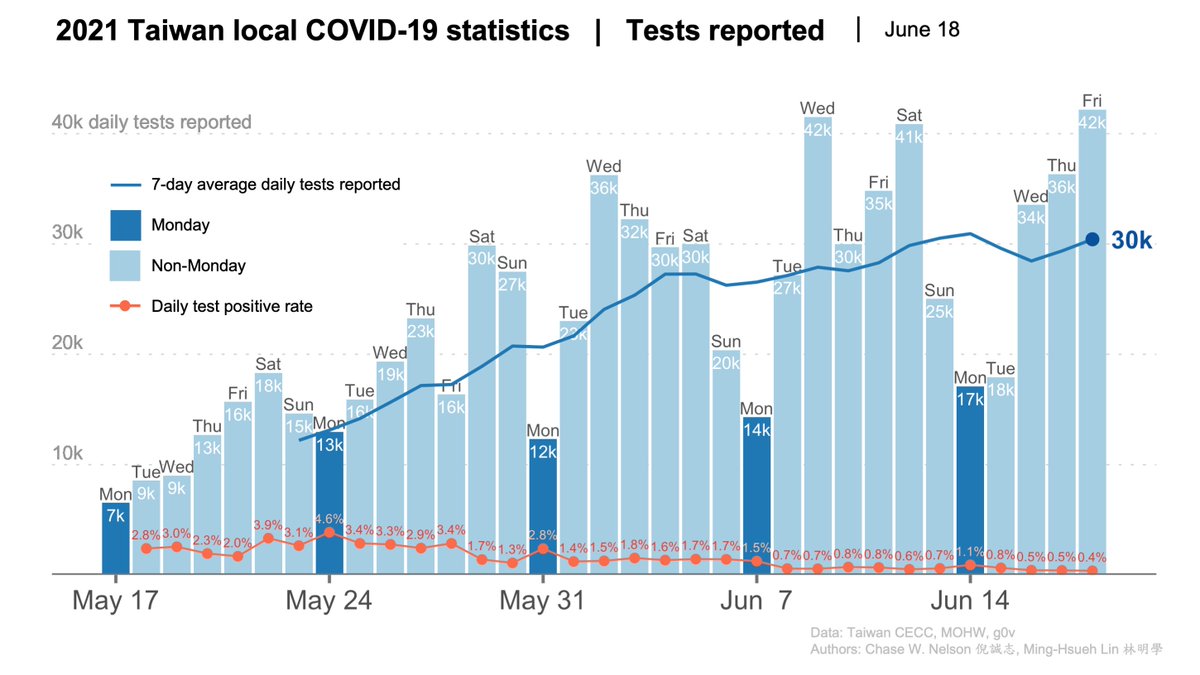TODAY’S (6月18日) #COVID19 update for #Taiwan 🇹🇼
📈187 local + 1 imported cases 📉trend
📈21 deaths 📉trend
📉0.4% test positive rate
📈3.9% case fatality rate (CFR) since May 1
🧪42k tests 📈capacity
💡Good to see a record high tests (42.2k) and record low positivity (0.4%). 1/6
📈187 local + 1 imported cases 📉trend
📈21 deaths 📉trend
📉0.4% test positive rate
📈3.9% case fatality rate (CFR) since May 1
🧪42k tests 📈capacity
💡Good to see a record high tests (42.2k) and record low positivity (0.4%). 1/6

DAILY CASES REPORTED (pink bars) and their 7-DAY AVERAGE (pink line), where each day is the mean of itself and the previous six. DEATHS (crimson red bars) are seen at the bottom.
DEATHS AGE DISTRIBUTION for May 1-June 18:
🔴64% are ≥70
🔴26% are 60-69
🔴10% are 30-59 years
2/6
DEATHS AGE DISTRIBUTION for May 1-June 18:
🔴64% are ≥70
🔴26% are 60-69
🔴10% are 30-59 years
2/6

AGE DISTRIBUTION OF CASES. Local cases from May 1-June 17 (age data for cases lag by a day), including those with missing locations. Only a single category is provided for ages >70, which constitute 14% of all cases.
DATA ➡️ data.cdc.gov.tw/en/dataset/ags… 3/6
DATA ➡️ data.cdc.gov.tw/en/dataset/ags… 3/6

Our local case fatality rate for May 1-June 17 is 3.9%—higher than the world average of 1-3%. This is at least partly due to a disproportionate number of older cases, but also possibly indicative of undetected cases, as pointed out by @PankersPeter, @hyiptht, and others. 4/6 

CASES & DEATHS and their 7-DAY AVERAGE BY AGE for May 1-June 17 (latest age-matched data available). All frankly good news. Keeping eyes peeled for 1) a spike 1-2 weeks after Dragon Boat, when some traveled of necessity and 2) workplace clusters due to lack of #WorkFromHome. 5/6 

WORKPLACE MOBILITY remains relatively high in Taiwan. Our continued #COVID19 success arguably depends on updated guidelines, more #WorkFromHome, and innovative #testing. Check out our piece in today's #天下 @CWM_en (中文 version forthcoming) ⬇️ 
https://twitter.com/chasewnelson/status/14057841759871590446/6

• • •
Missing some Tweet in this thread? You can try to
force a refresh













